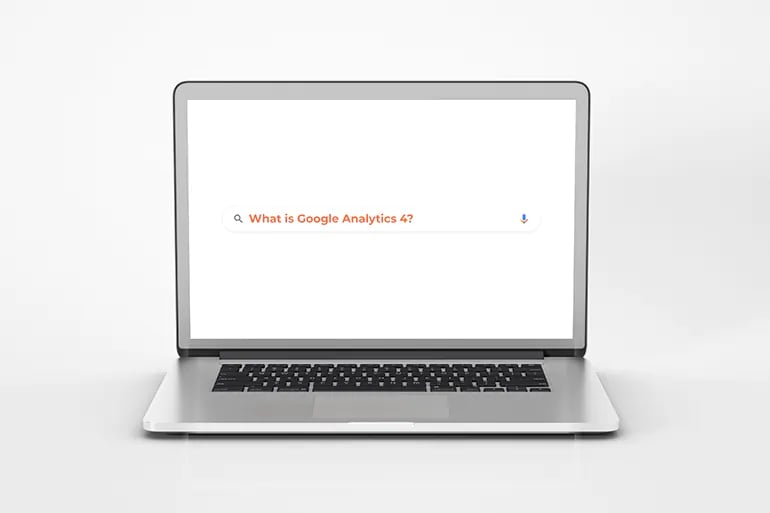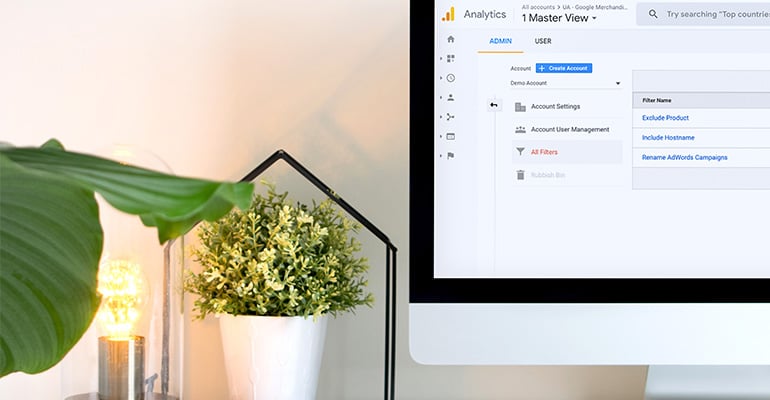
Google recently announced the planned retirement of its Universal Analytics properties within the Google Analytics platform, which are currently due to stop collecting data as of 1st July 2023. Moving forward, Google Analytics 4 (GA4) properties will become the only property choice on the platform. Whilst this change may seem like a long way off, it is vital to begin your preparation and planning now to ensure your company isn’t adversely impacted come July 2023.

What Are Google Analytics Properties?
Within your company’s Google Analytics account, properties exist as a data source (such as your website) that have been assigned a unique tracking ID. Data sent to this ID is stored at the property level, which is then accessed either via user created views or reports, depending on your property type. At the time of writing, there are two (soon to be one) property types, which can be identified by the letters prefixed onto their tracking ID:
- Universal Analytics (UA) properties have been the standard for many years and can contain multiple filtered views to easier segment and analyse data.
- Google Analytics 4 (GA4) properties are Google’s latest property type that is set to replace its UA counterpart.

What is GA4?
Google Analytics 4 (GA4) is the next evolution of Google Analytics, following on from its predecessor, the current Universal Analytics (UA). This new iteration uses an event-based data model and looks to combine mobile app and website data into one single Google Analytics property, allowing businesses to track user journeys more effectively and leverage Google’s machine learning capabilities to highlight and predict new insights.
As the digital world is an ever-changing environment, marketeers are regularly presented with new hurdles to adapt to and overcome, such as the introduction of GDPR, requiring the implementation of cookie consent banners in order to effectively track traffic. GA4 aims to reduce reliance on cookies to track visitors by using machine learning to fill in any gaps on a user journey where this consent was not given.
As of 1st July 2023, any Universal Analytics properties you are using in Google Analytics to collect data for your business will stop processing new hits, whilst any Analytics 360 properties, the paid-for counterpart to Analytics designed with large enterprises in mind, will follow suit as of 1st October 2023. Following these dates, you will only be able to access your data from these properties for a further six months.
So why the urgency? Well, it’s all about the data. Historical data is crucial for any business, allowing you to draw comparisons and benchmark performance. Without historical data, it is much harder to draw insight and make informed decisions. We suggest making the move over to a GA4 property as soon as possible to begin building historical data before your UA property stops processing new data. For example, setting up your GA4 property by 1st July 2022 will allow you to begin to make year-on-year comparisons as soon as your UA properties stop collecting data a year later.
What Are The Key Differences Between UA & GA4?
For the past decade, we have grown familiar with Universal Analytics properties and what they have to offer, so navigating your transition to GA4 and understanding why Google are making these changes may seem overwhelming. There are multiple differences between these two iterations that you should know about. Here is a little more about the key ones, though it is worth noting that we think the changes are likely to keep coming between now and next summer:
Data Streams
Data streams have been introduced as part of the new GA4 structure. In Universal Analytics, you may have had multiple properties for each data source, which are then further broken down into specifically filtered views to suit your needs. Data streams allow you to now connect all your data sources, such as website, iOS app or Android app, to one single property.

Properties, Views and Reports
Views no longer exist in GA4. All your data is instead viewed at the property level, which can then be viewed with all your data streams either aggregated or separated individually. With UA properties, you could create views specific to certain regions, devices etc, however in GA4 this is achieved with their reporting tools. GA4 allows you to easily create and save filtered reports for quick access to specific data.
Filters
Filters on GA4 have changed too. In contrast to Universal Analytics properties, you will no longer have multiple views with various filters applied to your data. GA4 has a property-wide filter system which can be used to filter internal and/or developer traffic. These filters will be limited to 10 per view. This is a significant change from the Universal Analytics approach, as separate filtered views are no longer required (nor possible). Filters, such as including/excluding specific countries, can now be managed within custom created reports found within the "Explore" tab of GA4. Up to five segments can still be applied to data within the "Reports" tab, however the creation of custom reports allows you to define and filter a data set to your liking, before saving it for easier access at a later date.
Automatically Collected Events and Enhanced Measurement
Many basic events are now automatically tracked by GA4, such as user engagement and first visits. GA4 properties also introduce a toggle for the new ‘Enhanced Measurement’ feature which allows for further automatic tracking of specific events, such as video engagement and outbound link clicks, without the need for any additional coding/tagging. Whilst this can be beneficial to many users, these automatically tracked events may not contain all the specific parameters you require for detailed reporting of your business; therefore, it is worth considering your specific needs and potentially opting to create your own tracking for such events.
Goals Are Now Conversions
Creating goals within your Universal Analytics views was a simple task which provided speedy insight into your business’ performance in key areas. With GA4, goals are now referred to as conversions, and are entirely event-based. Within your events configuration, you will see a list of all events the property has received, with a toggle switch to set this specific event as a conversion, with no extra parameters specified – no more ‘Category, Action, Label’ previously seen in UA’s event-based goal creation! Whilst this may seem like it simplifies the creation of conversions, what if you don’t want all file download events that Google’s Enhanced Measurement automatically tracks to trigger a certain goal, and you only want specific files to be counted within this goal? Well, read on!
Parameters, Custom Definitions and Creating Events
Events in Universal Analytics could be identified with a category, action and label, GA4 changes this approach by only having a single name for each event, along with a list of parameters. For example, with Google’s new Enhanced Measurement feature, any file download event will be seen as “file_download” and will also include dynamic parameters for: file_extension, file_name, link_url and more. Whilst Google provide some recommendations, we can create our own event names and custom parameters. Be sure to take a look at Google’s automatically collected events and parameters, the list of events collected by Enhanced Measurement, and their recommended event names. Whilst this is great for collecting data on each event, by default only the top-level event name will be seen within your reports. To see these parameters at a reporting level, they must be added under the Custom Definitions configuration.
Parameters can be used to separate events from each other that may otherwise look identical, such as signalling if a file_download event was a brochure for product A or B. To now create a conversion for product A brochure downloads, we can utilise GA4’s event creation tool, which will fire a new event if specific parameter conditions are met. For example, if the event “file_download” has a file_name parameter with the value of “product_A”, fire an event called “product_a_brochure_download”, and we can then mark this new event as a conversion.
Future Changes
Despite now being over two years old, GA4 is still receiving updates and changes from Google, and many things are still to be uncovered, such as the extent of Google’s machine learning capabilities. We will keep you updated as more changes are announced, and new best practices are identified.
How Can Your Business Prepare for GA4?
It is still relatively early days when it comes to GA4 and businesses adoption and use of the platform. Google are also highly likely to continue to evolve the features available in GA4 too, so what we see right now may not be what we get when UA is switched off next year. However, it is never too early to prepare for these changes, so here are some things you should do as soon as you can in preparation:
Familiarise Yourself
Even before the technicalities of tracking, conversions etc. are setup, you can create a GA4 property now within the same account as your UA property and have a look around at its features and reports. There will be new interfaces and terminology to familiarise yourself with.
Plan Ahead
Consider what is most important for your business to report on and identify what information you need to see, no matter how granular. Refer to Google’s automatically collected events and Enhanced Measurement events and consider what else is required. This will help you recognise which reports should be set up as well as provide insight into how to approach event tracking.
Don’t Delay
We’ve already discussed the importance of having access to historical data within your account. If you want to make year-on-year comparisons on GA4 from July 2023, then start collecting data now! Don’t forget to export your data from your Universal Analytics property come July 2023 – you will have six months to do so before it is no longer accessible.

Get Ready for GA4
The migration over to GA4 brings a lot of changes to how we capture and view data when compared to Universal Analytics. There are many new tools at your disposal, and you may initially feel as though many features you rely on are absent – but don’t panic! Spend some time getting acquainted with your new property, plan ahead to outline what it is you need from GA4, and then begin taking steps towards implementing – if you are reading this, then you’re already ahead of the curve!
Innovation Visual can help with your transition to GA4. Get in contact with us to start a conversation about how we can help get your business GA4 ready and ensure you have continuity of data and can make the most of the news insights GA4 can offer.


.png?width=250&height=141&name=image-gen%20(1).png)








